Mirage IIIE
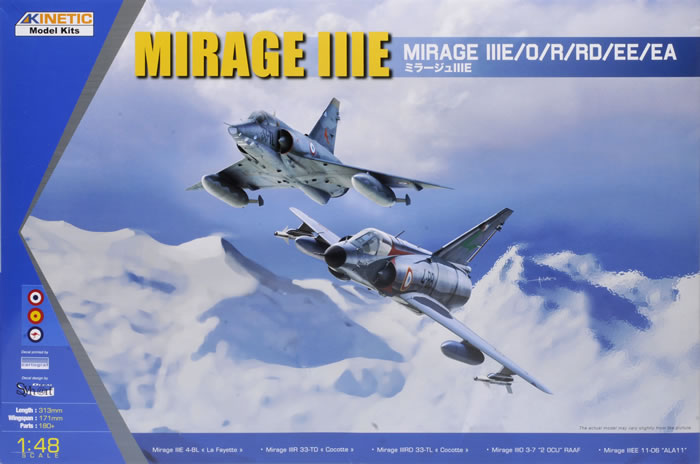
Kinetic, 1/48 scale
S u m m a r y |
| Item No. |
Kinetic Model Kits Item No. K48050 - Mirage IIIE |
| Contents and Media: |
More than 270 parts in grey plastic and 15 parts in clear; markings for five schemes. |
| Scale |
1/48 |
| Price: |
USD$39.99
plus shipping available online from Lucky Model |
| Review Type: |
FirstLook |
| Advantages: |
Great detail and sharp panel lines; accurate detail; extensive weapons load; crisp decals |
| Disadvantages: |
No typical Mirage III underwing fuel tanks; no Matra 530 Air to Air missile; wheel wells lack wiring. |
| Recommendation: |
A superb kit of the Mirage IIIE series and definitely the best on the current market. Highly Recommended. |
Reviewed
by Mick Evans

HyperScale is proudly supported by Squadron.com
This new release from Kinetic has been eagerly awaited since Kinetic released the Kfir kit nearly two years ago. The progression to the Mirage III was an obvious choice with much of the moulding engineering already completed for the Kfir.
Previously there have been some releases of the Mirage by various manufacturers with the Mirage IIIC being released by Heller and Esci which were good kits for their time but were totally superseded by the Hobbyboss release and the excellent Eduard releases.
The Mirage IIIE in 1/48 scale was serviced by the ordinary Academy kit and the reasonable Esci/Italeri release.
The best kit on the market was the Multimedia Fonderie Miniatures kit which used the Heller Mirage IIIC kit with a new IIIE fuselage and multiple resin parts to make an accurate and very good looking Mirage IIIE. When Heller first released the Mirage IIIC the modelling community was buzzing with rumours that Eduard would go on to complete the entire Mirage family but nearly 10 years on and no further progress.
The Mirage is one of my favourite aircraft as it was the first aircraft that I worked on after my initial apprentice training in the RAAF and I continued to work on it for over seven years from 1980-1988. I got to learn all the little nuances of detail of the Mirage IIIO and IIID over the years so I was keen to see how accurate this kit was from Kinetic. There are many plans around for the Mirage so it is very easy to compare and I spent 3 months building and rescribing the old 1/32 Scale Revell Mirage as a Mirage IIIO in mid-2014.
I have spent many hours poring over the accuracy of this kit as I had a pre-production version of the kit sent to me by Kinetic in November 2014 for a review check. I was able to check detail and accuracy against various Mirage kits and plans and against the excellent Mirage IIIO by Darren Mottram and Paul Mason.
Kinetic has not let us down. I would rate this as one of Kinetic’s best kit to date - accurate and with good detail.
The surface detail is fine and restrained and represents the panel lines of the Mirage that I am used to without being overdone and trench like. My only comment on surface detail is the fine rivet detail. The Mirage is constructed using flush countersunk rivets which are not really visible on the full size aircraft unless it is in its early bare metal schemes, while Kinetic has done a great job with very fine rivet lines they really could have left them off, particularly in 1/48 scale.
The kit contains over 270 light grey injection moulded parts and 15 clear parts. The fuselage is basically two one piece halves to which is added the nose cone, wings and intakes. One important detail that all kits of the Mirage IIIE/V manufacturers miss but Kinetic have included are the rear radio hatch bulges located just below the pitch dampers on the lower rear fuselage, big plus for this. The intakes are amazing having full intake ducting back to the engine compressor face, another big plus.
The wings are spot on, the anhedral looks correct, panel detail is superb and correct. Most importantly every vent around the gun troughs and gun bay have been moulded, something missed on all earlier Mirage models. The small air scoop on the front of the gun bay is included and this is only fitted to the gun pack and not the gun bay fuel tank so check your references for this and remove it if you are not modelling an aircraft fitted with the gun pack. This would also mean removing the gun barrels from the gun troughs. The Mirage rarely flew with the gun pack fitted, instead opting for the extra 72 gallons of fuel that could be fitted in the gun bay fuel tank.
The wheel wells look good but they are missing all the hydraulic pipework that is evident in the real thing.
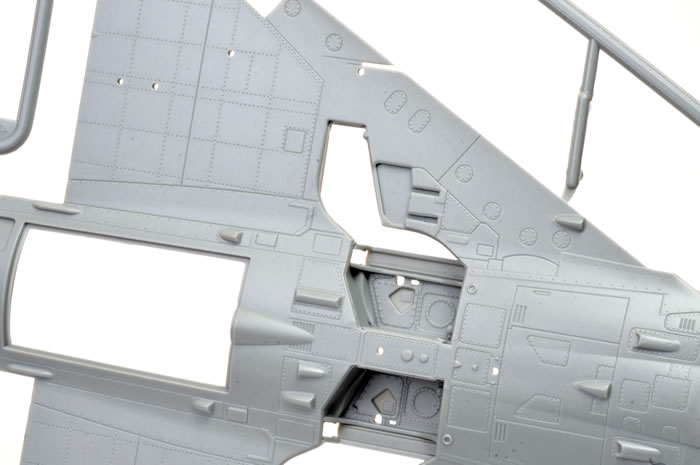
My only other minor point is the speed brake bays. Separate speed brakes is a first for any Mirage kit and is greatly applauded as most of the time when a Mirage is on the ground the speed brakes are slightly cracked open. The speed brakes are used by the pilot to bleed the hydraulic pressure after the engine has shutdown, and depending on the skill of the pilot was to how far these were cracked open. The best pilots got them back to streamlined or almost. Kinetic’s moulding has a small compromise on the edges of the speed brake bays where they are not quite vertical but slightly chamfered. A few scrapes with a sharp knife should enhance this area.
The nose wheel well detail looks great as does the undercarriage legs and doors. Optional leg doors are supplied for the IIIE and IIIO version, but only the IIIE flipper doors (main wheel cover) are supplied. The IIIE door has extra structural ribbing across the large flat surface inside the door and this will need to be removed for a Mirage IIIO version. This should only require a few scapes of a sharp knife and some sanding.
The main wheel hubs are a bit bare in not having the bolt detail that is fairly prominent on the Mirage main wheel hubs.
The cockpit has sufficient detail with alternate ejection seats and instrument panels being provided. A Martin Baker Mk4 ejection seat is provided for the early IIIE and IIIO version. You will need to source an after-market Mk6 seat if you wish to Model a IIIO post 1981/3 as all IIIOs had a Mk6 fitted from 1983 onwards and in particular for the RAAF grey scheme supplied in this kit.
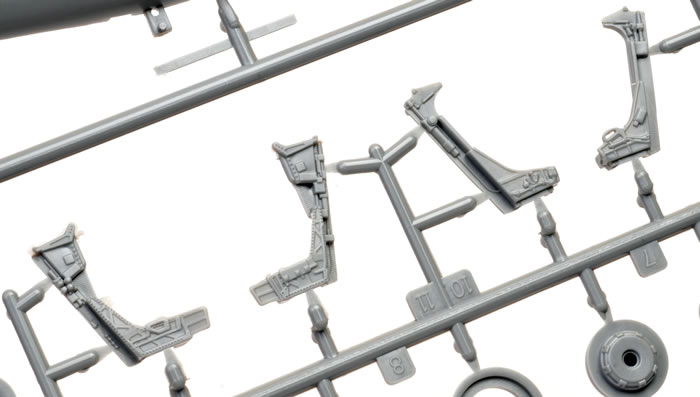
The alternate Mk10 seat is provided for the Mirage IIIRD version.
Two alternate instrument panels are supplied for the different versions. The panel for the IIIR/RD has the appropriate reconnaissance camera control panel fitted but the panel for the IIIE/EA/O while very accurate for all detail including the gunsight the radar scope that dominates the centre panel area just under the gunsight is under done in size. This is an easy fix for the IIIO as the RAAF always flew with a flexible rubber scope tube fitted to cut down on sun glare on the scope. A short piece of tube or hollowed sprue fixed into place will suffice to correct this issue.
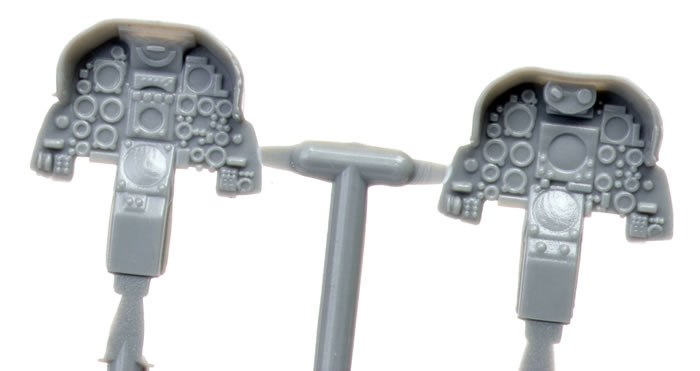
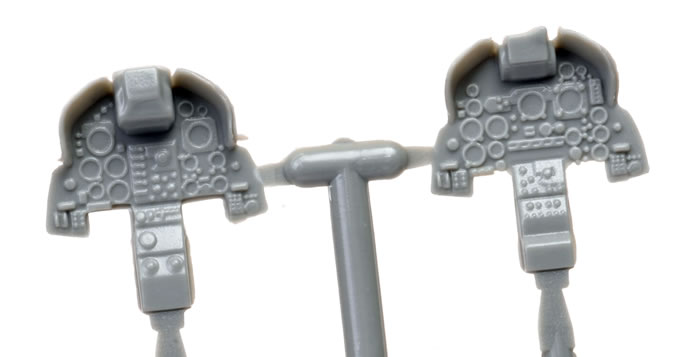
Alternate upper equipment bay hatches for just behind the cockpit are provided. The hatch for the IIIO will require the locating hole for the dorsal antenna to be filled as this antenna was not fitted.
Alternate pitot probes for just in front of the windscreen are provided to cater for all versions as are the alternate Doppler panels for underneath the forward fuselage.
Alternate nose cones are also provided for the radar nosed fighter version along with the photo reconnaissance nose for the photo reconnaissance versions.
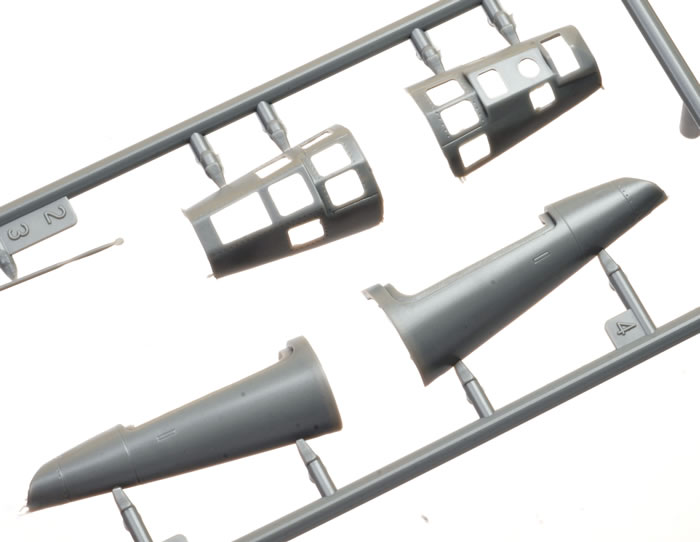
Kinetic also provide separate elevons and pitch dampers along with elevon actuator covers for either streamlined or drooped. Now if the pitch dampers were deselected as normal prior to engine shutdown, the pitch dampers will be streamlined, rarely are these drooped, this can only occur if someone had the pitch dampers selected with hydraulic power on and was moving the flight controls when the hydraulic power bled down. The elevons are totally different; these will always be in the drooped position unless there is hydraulic power supplied by the engine, emergency hydraulic pump or external hydraulic cart for maintenance.
To cater for the various configurations of the fin, Kinetic have engineered a series of drop in parts to allow all versions to be built. The only kit surgery required is the removal of a small spike antenna on the leading edge of the fin for the IIIO and IIIEA versions.
The upper fuselage heat exchanger intakes are moulded separately which gives them a nice hollow look when fitted. The under wing scoops and ducts are all moulded in place with a level of undercut in the moulding. These can easily be improved by some drilling to improve their hollow look.
I have read in various places some concern around the intakes being undersize on the Kinetic Kfir and this had carried through to the Mirage. These comments sent me to look at the three Kinetic Kfirs that I have built. I lined my Kfir C2 alongside an Esci Mirage IIIE that I had converted to a Kfir C2, a Fonderie Miniatures Mirage IIIE, a Heller IIIC and an Eduard IIID. All kits had similar sized intakes except for the Eduard IIIC which are slightly larger and now in comparison actually look a bit oversize. I then compared the Heller, Esci, Eduard and Kinetic intakes to several 1/48 line drawings. I used several line drawings to ensure accuracy of the drawings. All intakes except for the Eduard kit matched the profile perfectly in height. The Eduard intakes were about 0.5mm too high. To match the width of the intake was difficult but all intakes are close in measurement. This was also confirmed by matching the intake parts from each kit, which is no easy task given that some of the intake shape is incorporated into the lower wing part. Noticeable though is the difference in the profiles of the intake shock cones in each kit. The shock cones, often referred to as mice due to their profile move forward during supersonic speed to keep the shock wave out of the intake and reduce the size of the intake opening. The Eduard and FM kits seem to have the profile correct with all other kits including the Kinetic kit to be undersized. In other words the profile of the mice should match the round profile of the intake. In their retracted position (subsonic) the intake opening is quite large with the opening a linear shape but in the extended position (supersonic the intake opening reduces to quite a small area but is still a linear opening. The undersize shock cones are not apparent from a side profile view but is apparent from a front elevation view if you are looking down the intake.
While I had the 1/48 scale drawings next to the kit, I took the opportunity to check the Kinetic Kit dimensions. The kit is almost perfect with no significant issues.

The transparencies look great and are crystal clear; most importantly they are the correct shape.
Ordnance
he stores supplied for this kit is extensive with the following supplied:
-
AIM 9B Air to Air Missile
-
Matra Magic 550 Air to Air Missiles
-
Mk82 Retarded Bombs
-
RP19R (110G/500L non-jettisonable supersonic tank)
-
Matra JL-100 (rocket launching tank)
-
Matra RPK10 (bomb launching tank)
-
LAU-32 (rocket launcher pod)
-
Nord AS30L Air to Ground Missile
-
RP30 - 1700L tank
Both the AIM 9B and Matra Magic 550 air to air missiles make up from multiple parts and look to be very accurate. There is no mention in the instruction sheets of how to fit the Matra Magic 550 to the aircraft. On the Mirage III this requires a special adaptor fitting between the outboard station pylon and the matra launcher rail. The lancher rail is set at about 43 degrees to the vertical. Kinetic have supplied the parts Z6 and Z7 in the kit with the adaptor and launch rail being moulded as one piece but there is just no mention this in the instruction sheet.
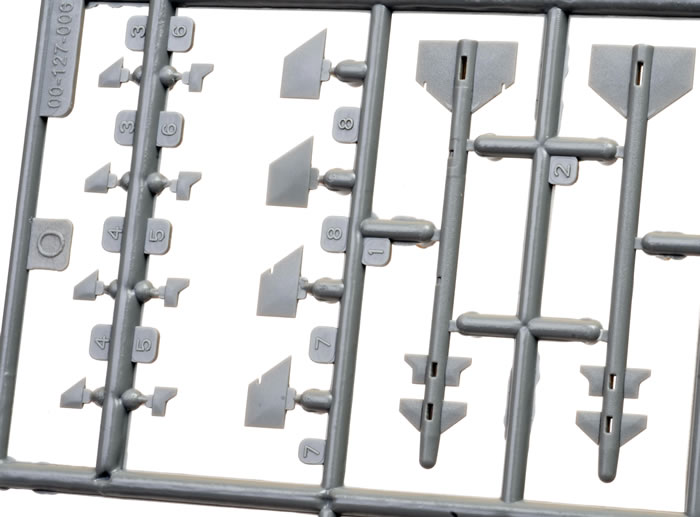
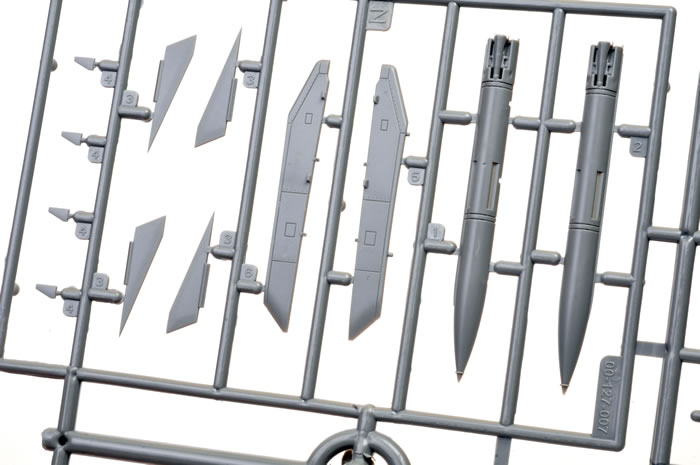
Unfortunately the main air to air armament for the Mirage IIIE is missing. This is the Matra 530 radar guided air to air missile along with is dedicated pylon. This would have been a very nice addition and will need to be sourced from either an Eduard or Esci Mirage kit.
The large 1700lt/450G tanks supplied are used by some Mirage III opeators. The tanks fit very close to the under surface of the wing whereas the more common Mirage III tanks are normally carried on a much larger pylon which has them standoff the wing surface by a few feet. I would have thought a good addition would have been the 1100lt/286G or the 1400lt/374G subsonic fuel tanks.
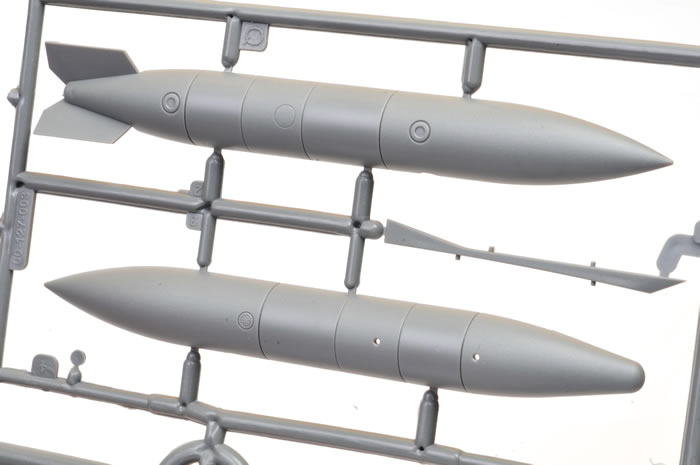
A 286G tank would have allowed for either a wing pylon fit or a centreline pylon fit and both of these options are supplied in the Kinetic Kfir kit. The only other option would have been the centre line dual inline bomb pylon.
The RPK 10 tanks may be an area of contention. The RPK 10 used in Australian service had the front bomb pylons staggered not side by side. The supplied RPK 10 has the bomb pylons side by side. This is verified on many other operators who used the RK10 tanks similar to the one operated in Australia. Having said this there are many photographs of a 110G supersonic tank with no staggered bomb pylons, but from the photographs the nose profile of the tank is slightly more rounded that the tank supplied in the kit, I cannot verify this as I am only familiar with the RK10 tank with the forward bomb pylons staggered. You will need to check your references and if required move the inboard pylon forward the width of the bomb pylon.
Markings
There are 5 schemes provided by Kinetic for this kit with the decals printed by Cartograf and the decals designed by Skyhart Decals.
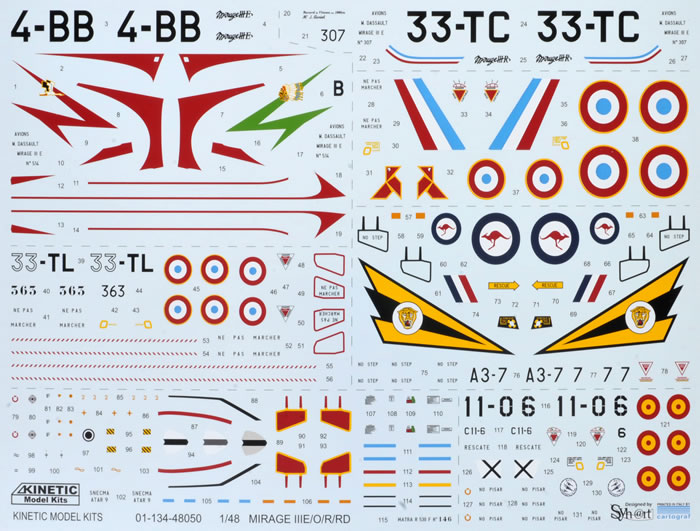
The markings supplied are as follows:
French Air Force:
-
Mirage IIIE 4-BB of Squadron EC 1/4 “La Fayette” of the Armee de l’ Air BA 116 based a Luxeuil in 1967. This aircraft appears to be in a high speed aluminium scheme.
-
Mirage IIIR 33-TC of Squadron EC3/33 “Mosselle” of the Armee de L’ Air based at Strasbourg – Entzheim in 1963. This aircraft is finished in a camouflage scheme of Grey and Green upper surfaces and high speed aluminium under surfaces. This aircraft attempted the feminine world record for speed over a closed circuit of 100km flown by Jacqueline Auriol on 14 June 1963 at an average of 2038.7km/h near Istres air base.
-
Mirage IIIRD 4-BB of Squadron EC 1/4 “La Fayette” of the Armee de l’ Air BA 116 based a Luxeuil in 1967. This aircraft is finished in natural metal.
Royal Australia Air Force:
Mirage IIIO Serial A3-7 of No 2 Operational Conversion Unit of the Royal Australian Air Force based at Williamtown in 1987(?)
This aircraft is finished in an early Grey scheme as an experimental for the new F/A-18 Hornets.
The date of 1987 is not correct for this aircraft and it would be 1984-85. All Williamtown Mirages were transferred to No 77 Sqn in late 1984/85 and the No 77 Sqn tail flash replaced all 2OCU tail flash markings. No 2OCU started to operate F/A-18 Hornets from 1985 onwards.
Also, Mirage IIIOs would most likely not carry AIM 9Bs from 1982 onwards as the wings were modified for the Matra 550 and all aircraft had MK6 ejection seats fitted from this time as well.
If you model an IIIO in a grey scheme or post 1982 you need to take this into account.
Spanish Air Force:
Mirage IIIEE Serial C11-6 of Ejectito del Air "ALA11" based at Manises Air Base in 1986.
This aircraft is finished in a camouflage scheme of Grey and Green upper surfaces and high speed aluminium under surfaces.
Kinetic has delivered a superb 1/48 scale kit of the Mirage IIIE series and this is definitely the best on the current market. Very little that I can criticise with the actual kit and I am full of praise except for the selection of underwing fuel tanks and no Matra 530 missile being included.
I cannot wait to build this kit and see how it assembles, but it looks like it will be a breeze.
Big kudos to Kinetic for this excellent kit.
Highly Recommended.
Thanks to Lucky Model for the samples
Review Text Copyright © 2015 by Mick Evans
Images Copyright © 2015 by
Brett Green
Page Created 8 January, 2015
Last updated
9 January, 2015
Back to HyperScale Main Page
Back to Reviews Page
|
Home
| What's New |
Features |
Gallery |
Reviews |
Reference |
Forum |
Search